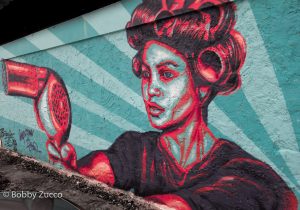Natalia Gonzalez
My name is Natalia Gonzalez and I will be analyzing Elizabeth Acevedo’s poem entitled “Hair”. This portfolio will be using a CC-BY-NC license
Introduction:
I will be analyzing how Elizabeth Acevedo uses spoken word poetry to stand up against colonial perceptions of beauty in her Dominican community. She emphasizes how she wants to liberate herself and those around her from the Dominican beauty expectations that are rooted in colonialism and anti-blackness. She attempts to make the audience understand how harmful these expectations are and highlights the importance of subverting traditional norms.
Themes:
In “Hair”, Elizabeth Acevedo is reflecting on how Dominicans are taught to reject their natural hair to gain a proximity to whiteness. She talks about how it is expected of Dominican women to straighten their hair to distance themselves from their Afrocentric features. Through the rejection of these beauty norms, Elizabeth Acevedo also uses the poem to show how hair and beauty can be a tool of decolonization.
Analysis:

“My mother tells me to fix my hair. And by fix, she means whiten”- Elizabeth Acevedo
As the opening line in her poem, Elizabeth Acevedo is trying to communicate how Dominican women perceive curly hair. Throughout the country and in other parts of Latin America, curly is seen as something that needs to be tamed and fixed. In Dominican Republic, there are two types of hair, a person either has pelo malo (bad hair) or pelo bueno (good hair). Pelo Malo is described as hair that is kinky with tight curls and coarse. Pelo bueno is hair that is straight and soft, or loosely curled (Candelario 2000). Dominicans see curly hair as something undesirable and will do anything to achieve straight and soft hair. By using the word “fix”, Elizabeth is trying to put emphasize on how Dominicans see their natural hair as something broken. Despite most women in Dominican Republic having naturally curly hair, they spend their entire life “fixing” or straightening their hair. Elizabeth Acevedo says that her mother told her this, showing how a rejection of natural hair is passed down from generation to generation. As seen in the image above, a Dominican mother is “fixing” her hair while “fixing” the hair of her daughters. Dominican girls are taught from an early age to view their natural hair as something to be ashamed of and they should do something to “fix”.

“They say Dominicans can do the best hair. I mean they, wash, set, flatten the spring in any loc. What they mean is we’re the best at swallowing amnesia”- Elizabeth Acevedo
Dominican hair salon can be found all over the United States. It is very common to see Dominican women walking around their towns with rollers in their hair as seen in the image above. Dominicans are known for how well they can straighten hair, there is even a joke that says that Dominican hair stylists sneak relaxer in to achieve pin straight hair. In this line, Elizabeth Acevedo is trying to show that Dominican women use their hair to reject the features from their African ancestry. Dating back to colonialism, the Spanish forced Dominicans to embrace whiteness and Catholicism as a means of control and to distance themselves from their neighboring country of Haiti. Straighten hair is a way to erase their African roots and embrace the beauty standard left by their Spanish colonizer. Elizabeth Acevedo is showing how common it is for Dominican women to use hair to push away their history.

“And I don’t tell them that we love like sugar cane, brown skin, pale flesh, meshed in pure sweetness, The children of children of field. Our bodies curve into one another like an echo, and i let my curtain of curls blanket us from the world. How our children will be beautiful. Of dust Skin, and diamond eyes, hair a reclamation. How I will break pride down their back so from the moment they leave the womb, they will born in love with themselves. My Momma tells me to fix my hair, and so many words remain unspoken. Because all I can reply is, “You can’t fix what was never broken”- Elizabeth Acevedo
in the closing section of the poem, Elizabeth Acevedo show how she will use her hair to push back against what she has been taught. She states that she will embrace her past and she acknowledges that she along with most Dominicans are descendants of slavery. She affirms that she is ready to break the cycle of hiding her natural hair because she recognizes it as a denial of truth. She says that she will teach her children that they are beautiful, and they should embrace their afrocentric features. Acevedo states “I let my curtain of curls blanket us from the world”. She personifies her hair to emphasize how she will wear her natural hair as a shield and a symbol against the colonial beauty standards. In this way, hair and beauty can be used as a means of protest. In Dominican Republic, the act of embracing one’s natural hair and black skin is seen as something rebellious and subversive. In her closing statement, Acevedo circles back to her opening line. She boldly states that her hair was never broken and there has never been anything to “fix”, any attempts to do so came from colonialism.
Application
Acevedo uses this poem to highlight an issue in Dominican culture. The idea of straightening one’s hair is so common within Dominican culture, it is just accepted as a norm. Using imagery and metaphor, Acevedo breaks apart this norm and uses her hair as an act of rebellion. This poem is important because it brings light to how pervasive colonial ideals are within our society. It also helps the audience reflect and potentially dismantle other ideas left behind by colonialism that are just accepted as a norm. There has been so much erasure of culture and history because of colonialism, poets like Elizabeth Acevedo are attempting to uncover the truths of our ancestors and reject the things we have been taught.

